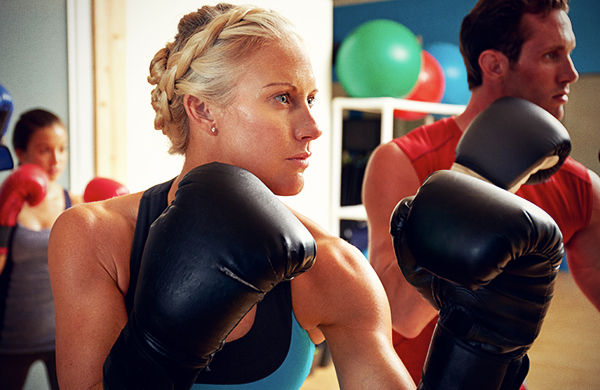
“This is a serious sport. … It’s not a game. You don’t play boxing.”
So says Jimmy Mango, while schooling me—a complete beginner—on how to box. Jimmy co-owns Franklin Street Boxing Club with his business partner, Ray Pace. Both are experienced boxers; after his first fight at age 16, Jimmy was a finalist in Chicago’s most prestigious amateur boxing tournament, the Golden Gloves.
Jimmy not only has experience in the ring; he also has more than 20 years of experience as a boxing trainer. When I visited his gym, he walked me through my first-ever boxing workout, which included jump rope, speed-bag work, and some practice time in the ring with the mitts. (I got an abbreviated version of how to box: typical boxing classes also include shadow boxing and punching-bag work.) Like all his boxing training sessions, mine was broken up into short intervals to imitate a real fight. “Everything’s on the bell,” Jimmy explains. “Three minutes on, one minute off.”
While it’s true that you can’t “play” in a bout without getting punched, I discovered that you can have a lot of fun training in a boxing gym, even if, like me, you can only tell your right hand from your left 80% of the time.
Below are some boxing techniques and tips for other newbies interested in learning how to box. Some are from me, and some from Jimmy.

Don’t box barehanded.
This may seem obvious, but punching is hard on knuckles and wrists. To protect their hands, boxers wear hand wraps, which are long strips of cloth that wind between your fingers and basically bandage your palms and wrists. Add boxing gloves over the wraps, and suddenly your hands feel like giant bear paws.

A “punch” can mean many things.
There are different kinds of punches, and in just one session of boxing training, I learned three: jab, hook, and uppercut. Some basic principles apply to all three, though. For one, try to relax your arms. “[They] should be loose, like water,” Jimmy says. You should also breathe steadily. “When they throw punches, [people] hold their breath, and they get tired [faster],” Jimmy explains.
You have a lot of body parts.
Figuring out the difference between a right hook and a right jab is only the beginning. The hard part is executing either while your left hand protects your face and your weight is distributed evenly between your feet. Overall, you have to manage four limbs at any given time. It is like juggling four balls. Or driving four cars.

The ring doesn’t have a door.
Maybe everyone knows this but me, but even if you walk around the ring in a methodical fashion, you still won’t find a door. You just have to duck through the ropes without accidentally garroting yourself. You can do it.
You’ll punch your trainer a lot, but he’ll be fine.
To practice short combos, I punched Jimmy—but only in the hands, while he was wearing foamy, shovel-shaped mitts. They protected him from any (minimal) damage I could have inflicted, and because they moved with him, it semi-mimicked the experience of fighting an opponent.

Avoid your opponent.
Don’t run away from them. Boxing isn’t tag. However, Jimmy recommends keeping your opponent at arms’ length as you punch and trying not to lean toward them (or unconsciously wander toward them—a problem possibly unique to me). Maintaining personal space makes it harder for them to hit you back.
The speed bag takes some practice.
The speed bag looks like a little bulb, suspended below a circular platform. When you hit it, it bounces back and forth, pendulum-style. Every three bounces, you hit it again.
Once you learn to do this quickly and competently, à la Jimmy, it improves your hand-eye coordination and agility. However, the way I did it only improved my fearful leaping. Half the time it is swinging toward your face.
Don’t smile.
I smiled through the whole workout, and it is not a tough look. Try to develop a stoic boxing face. Unless you are Jack Nicholson, in which case smile away. You are terrifying.


